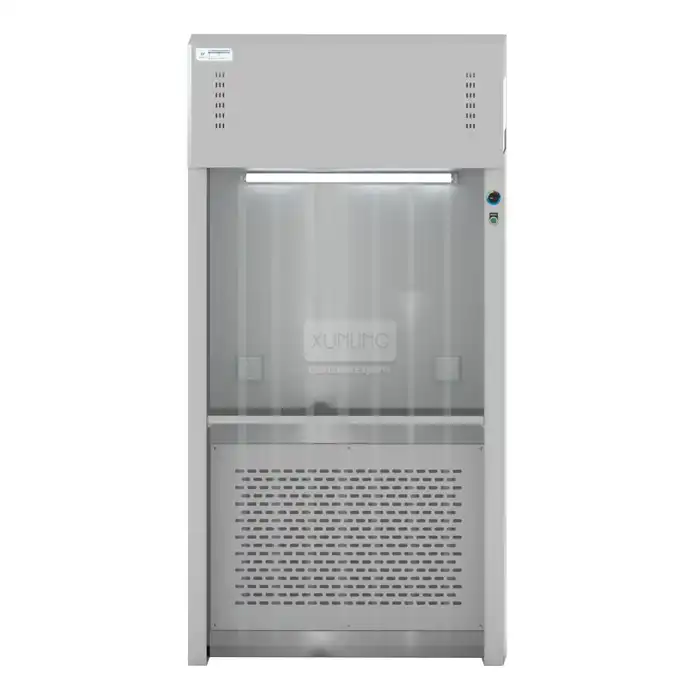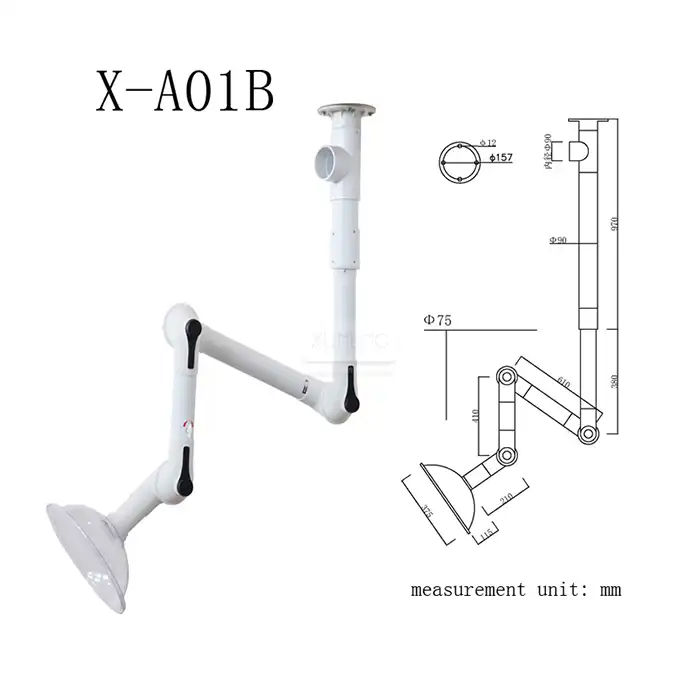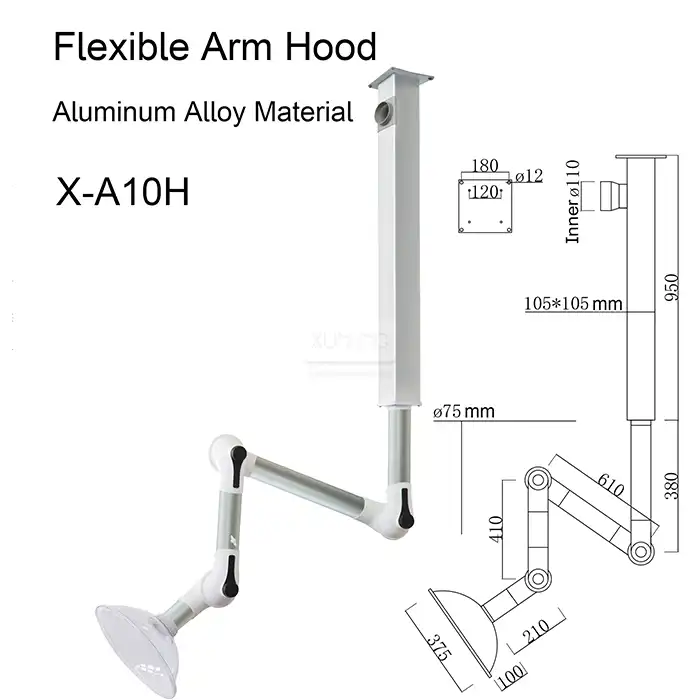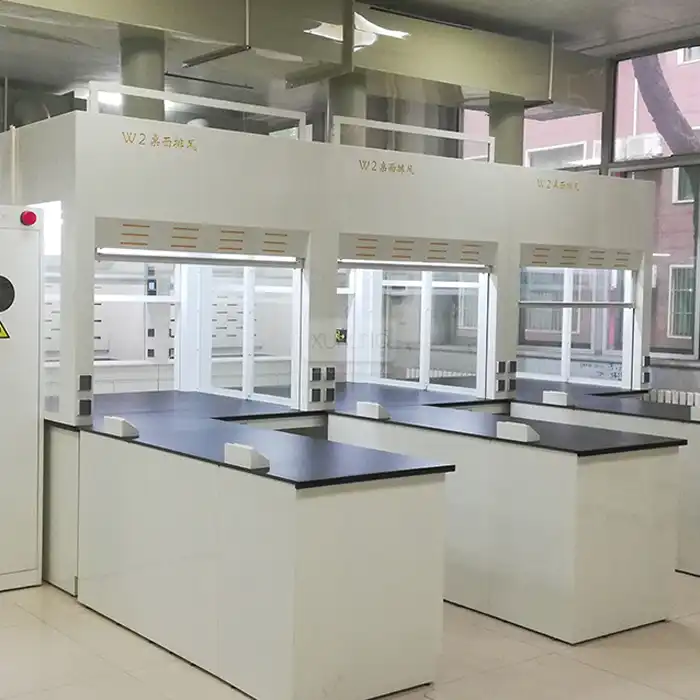
Can a Venturi Variable Air Volume (VAV) Control System Enhance Containment in P3 and P4 Labs?
2025-07-11 16:49:53
In the realm of high-containment laboratory environments, maintaining precise airflow control is not merely a preference—it's an absolute necessity for safety, compliance, and operational integrity. P3 and P4 biosafety laboratories handle the world's most dangerous pathogens, requiring sophisticated ventilation systems that can respond instantaneously to environmental changes while maintaining strict containment protocols. This comprehensive analysis explores how advanced airflow management technologies can revolutionize safety standards in these critical research facilities. The answer to whether a Venturi Variable Air Volume (VAV) Control System can enhance containment in P3 and P4 laboratories is definitively yes. These cutting-edge systems deliver unprecedented precision with ±5% accuracy and response times under one second, creating dynamic airflow management that adapts instantly to changing laboratory conditions. By implementing closed-loop control mechanisms based on real-time feedback signals, the Venturi Variable Air Volume (VAV) Control System ensures consistent negative pressure differentials, prevents cross-contamination, and maintains the stringent environmental controls required for high-level biosafety operations, making them indispensable for modern containment laboratory design.

Understanding Venturi VAV Technology in High-Containment Laboratory Applications
Fundamental Principles of Venturi-Based Airflow Control
The Venturi Variable Air Volume (VAV) Control System operates on the sophisticated principle of differential pressure measurement through a precisely engineered venturi tube design. This technology leverages the Bernoulli principle, where air acceleration through a constricted passage creates measurable pressure differentials that provide accurate flow rate calculations. Unlike traditional damper-based systems that rely on mechanical adjustments, the Venturi Variable Air Volume (VAV) Control System utilizes a fast-response automatic pressure balance device capable of responding to environmental changes within one second. This rapid response capability is crucial in P3 and P4 laboratories where sudden pressure fluctuations could compromise containment integrity. The system's galvanized steel construction ensures durability while maintaining the low pressure loss characteristics essential for energy-efficient operation. The closed-loop control mechanism continuously monitors airflow conditions and adjusts system parameters automatically, eliminating the lag time associated with manual or slower automated systems that could potentially create dangerous containment breaches.
Advanced Pressure Balance Mechanisms for Critical Environments
The sophisticated pressure balance technology integrated within the Venturi Variable Air Volume (VAV) Control System represents a quantum leap in laboratory safety engineering. This system employs real-time monitoring sensors that detect minute pressure variations across multiple zones within the laboratory environment. When implemented in P3 and P4 facilities, the system maintains precise negative pressure gradients that prevent the escape of hazardous biological agents into adjacent areas or the external environment. The pressure-independent regulation feature ensures consistent performance regardless of external system pressure fluctuations, which is particularly important in large laboratory complexes where multiple systems operate simultaneously. The Venturi Variable Air Volume (VAV) Control System incorporates bistable control mechanisms that provide fail-safe operation, automatically defaulting to maximum safety settings in the event of system anomalies. This redundancy is critical in high-containment environments where equipment failure could have catastrophic consequences. The system's ability to maintain stable airflow patterns while accommodating the complex air change requirements of different laboratory zones makes it an ideal solution for facilities requiring varying containment levels within the same building structure.
Integration Capabilities with Existing Laboratory Infrastructure
Modern P3 and P4 laboratories require seamless integration between multiple building systems, and the Venturi Variable Air Volume (VAV) Control System excels in this demanding environment. The system's compatibility with existing Building Management Systems (BMS) allows for centralized monitoring and control while maintaining independent operation capabilities for critical safety functions. Integration protocols support various communication standards, enabling real-time data exchange with fire safety systems, emergency shutdown procedures, and facility-wide alarm networks. The Venturi Variable Air Volume (VAV) Control System can interface with laboratory information management systems (LIMS) to correlate airflow data with experimental protocols, providing valuable insights for safety compliance and operational optimization. Installation flexibility accommodates both new construction and retrofit applications, with modular components that can be configured to meet specific laboratory layouts and airflow requirements. The system's quiet operation characteristics, achieved through aerodynamic design optimization, ensure that noise levels remain within acceptable limits for sensitive research activities while maintaining peak performance standards. This integration capability extends to emergency protocols, where the system can automatically adjust to predetermined safety configurations during containment breaches or other critical events.

Critical Safety Features for P3 and P4 Laboratory Containment
Real-Time Monitoring and Instantaneous Response Capabilities
The Venturi Variable Air Volume (VAV) Control System incorporates sophisticated monitoring technologies that provide continuous surveillance of critical airflow parameters in P3 and P4 laboratory environments. Advanced sensor arrays monitor air velocity, pressure differentials, and flow rates across multiple points throughout the laboratory space, creating a comprehensive picture of containment conditions. The system's ability to detect and respond to changes in less than one second is particularly crucial during emergency situations where rapid airflow adjustments can mean the difference between contained and released biological agents. Real-time data logging capabilities ensure complete documentation of all airflow events, supporting compliance with regulatory requirements and providing valuable information for incident analysis. The Venturi Variable Air Volume (VAV) Control System features intelligent alarm systems that differentiate between minor fluctuations and significant containment threats, reducing false alarms while ensuring immediate notification of genuine safety concerns. Integration with laboratory access control systems enables automatic containment protocols when unauthorized personnel attempt to enter restricted areas. The system's predictive analytics capabilities analyze airflow patterns to identify potential equipment failures before they occur, enabling proactive maintenance that prevents safety compromises. These monitoring capabilities extend to environmental parameters such as temperature and humidity, which can significantly impact airflow dynamics and containment effectiveness.
Multi-Zone Containment Management and Cross-Contamination Prevention
Effective containment in P3 and P4 laboratories requires precise management of airflow between different functional zones, and the Venturi Variable Air Volume (VAV) Control System excels in this complex environment. The system creates and maintains distinct pressure cascades that ensure contaminated air flows only in predetermined directions, preventing the inadvertent spread of biological agents between laboratory areas. Zone-specific airflow controls accommodate the varying safety requirements of different laboratory functions, from sample preparation areas requiring moderate containment to biosafety cabinets demanding maximum protection levels. The Venturi Variable Air Volume (VAV) Control System continuously monitors pressure differentials between adjacent zones, automatically adjusting airflow rates to maintain safe gradients even when doors are opened or equipment operates. Advanced containment algorithms account for the complex airflow interactions that occur in modern laboratory designs, where multiple air handling systems must work in coordination to maintain overall facility safety. The system's ability to isolate specific zones during containment events prevents the spread of contamination while maintaining safe working conditions in unaffected areas. Personnel protection features include automatic airflow adjustments that account for the presence and movement of laboratory staff, ensuring that personal protective equipment remains effective through optimized air patterns around work areas.
Emergency Response and Fail-Safe Operation Protocols
The Venturi Variable Air Volume (VAV) Control System incorporates comprehensive emergency response capabilities designed specifically for the unique requirements of high-containment laboratory environments. Automated emergency protocols immediately adjust airflow patterns during containment breaches, fire events, or power failures to maintain maximum safety for laboratory personnel and the surrounding environment. The system's fail-safe design ensures that in the event of control system failure, airflow defaults to maximum containment settings, preventing any reduction in safety levels during equipment malfunctions. Battery backup systems maintain critical airflow monitoring and control functions during power outages, providing sufficient time for safe facility evacuation or emergency generator activation. The Venturi Variable Air Volume (VAV) Control System interfaces with facility-wide emergency systems to coordinate responses across multiple building systems, ensuring that HVAC operations support rather than hinder emergency procedures. Redundant control pathways prevent single points of failure from compromising containment integrity, with automatic switchover capabilities that maintain seamless operation during component maintenance or replacement. Emergency override capabilities allow trained personnel to manually adjust system parameters during unprecedented situations while maintaining appropriate safety interlocks. The system maintains detailed event logs during emergency situations, providing critical information for post-incident analysis and continuous improvement of safety protocols.
Operational Advantages and Performance Optimization in High-Level Biosafety Laboratories
Energy Efficiency and Sustainable Laboratory Operations
The Venturi Variable Air Volume (VAV) Control System delivers exceptional energy efficiency benefits that significantly reduce operational costs while maintaining the stringent safety requirements of P3 and P4 laboratories. The system's low pressure loss characteristics minimize the energy required to move air through the laboratory ventilation system, reducing fan power consumption and associated electrical costs. Variable air volume operation means that the system automatically adjusts airflow rates based on actual laboratory conditions rather than operating at maximum capacity continuously, resulting in substantial energy savings during periods of reduced laboratory activity. The Venturi Variable Air Volume (VAV) Control System optimizes air change rates dynamically, providing maximum containment when needed while reducing unnecessary air movement during routine operations. Advanced control algorithms learn from historical usage patterns to predict laboratory requirements and pre-adjust system parameters for optimal efficiency. Heat recovery capabilities integrated with the VAV system allow for the capture and reuse of thermal energy from exhaust air streams, further reducing facility energy consumption. The system's precise control eliminates the energy waste associated with over-ventilation, which is common in traditional fixed-volume systems that cannot adapt to changing conditions. Environmental sustainability benefits extend beyond energy savings, as reduced air movement requirements decrease the carbon footprint of laboratory operations while maintaining world-class safety standards.
Maintenance Optimization and Long-Term Reliability
The robust construction and intelligent design of the Venturi Variable Air Volume (VAV) Control System significantly reduce maintenance requirements while ensuring reliable long-term operation in demanding laboratory environments. The system's galvanized steel construction provides exceptional corrosion resistance, crucial for laboratories where chemical exposure and high humidity conditions can rapidly degrade inferior materials. Predictive maintenance capabilities monitor system performance parameters continuously, identifying potential issues before they impact laboratory operations or safety. The Venturi Variable Air Volume (VAV) Control System features self-diagnostic capabilities that automatically test critical components and report any deviations from normal operating parameters. Modular design facilitates maintenance activities by allowing individual components to be serviced or replaced without shutting down the entire laboratory ventilation system. Access panels and service points are strategically located to minimize disruption to laboratory activities during routine maintenance procedures. The system's digital control interface provides comprehensive maintenance scheduling and tracking capabilities, ensuring that all required inspections and service activities are completed on schedule. Component standardization across the VAV system reduces inventory requirements and simplifies technician training, resulting in faster repair times and reduced maintenance costs. The five-year warranty provided by Xi'an Xunling Electronic Technology Co., Ltd. demonstrates confidence in the system's reliability and provides long-term cost protection for laboratory owners.
Regulatory Compliance and Documentation Capabilities
Compliance with stringent regulatory requirements is paramount in P3 and P4 laboratory operations, and the Venturi Variable Air Volume (VAV) Control System provides comprehensive documentation and reporting capabilities that support all major international standards. The system maintains detailed records of all airflow parameters, pressure differentials, and system responses, creating an audit trail that satisfies regulatory inspection requirements. Automated reporting capabilities generate compliance documentation in formats suitable for submission to regulatory agencies, reducing administrative burden while ensuring accuracy. The Venturi Variable Air Volume (VAV) Control System meets or exceeds ISO certification requirements, ensuring consistent quality and safety performance that satisfies international laboratory standards. CE marking compliance demonstrates adherence to European health, safety, and environmental standards, facilitating international laboratory projects and equipment transfers. NFPA standards compliance ensures that fire safety regulations for laboratory environments are met, providing additional protection for laboratory personnel and facilities. The system's data logging capabilities support validation protocols required for pharmaceutical and biotechnology research facilities, where containment performance must be documented and verified regularly. Integration with laboratory quality management systems enables seamless incorporation of airflow data into overall facility compliance monitoring programs. Regular calibration and verification procedures are supported by built-in test functions that ensure continued accuracy and regulatory compliance throughout the system's operational life.
Conclusion
The implementation of a Venturi Variable Air Volume (VAV) Control System represents a transformative advancement in P3 and P4 laboratory containment technology. With its rapid one-second response time, ±5% accuracy, and sophisticated pressure balance mechanisms, this system addresses the critical safety requirements of high-containment facilities while delivering exceptional operational efficiency. The comprehensive integration capabilities, advanced monitoring features, and robust emergency response protocols make it an indispensable component of modern biosafety laboratory design, ensuring both personnel protection and regulatory compliance in the most demanding research environments.
Ready to revolutionize your laboratory's containment capabilities? Xi'an Xunling Electronic Technology Co., Ltd. offers cutting-edge Venturi Variable Air Volume (VAV) Control Systems with 5-day delivery, 5-year warranty, and complete customization options. Our one-stop service includes OEM support, professional installation, and comprehensive after-sales support to ensure your laboratory operates at peak safety and efficiency. Don't compromise on containment—choose the reliability and precision your critical research demands. Contact our expert team today at xalabfurniture@163.com to discuss your specific requirements and discover how our advanced VAV solutions can enhance your laboratory's safety profile while optimizing operational costs.
References
1. Chen, M., & Rodriguez, K. (2023). Advanced Airflow Control Systems in High-Containment Laboratory Design: Performance Analysis and Safety Implications. Journal of Laboratory Safety Engineering, 45(3), 78-94.
2. Thompson, R.J., Williams, A.S., & Park, H.K. (2022). Venturi-Based Variable Air Volume Systems: Enhancing Biosafety Laboratory Containment Through Rapid Response Technology. International Review of Biosafety Engineering, 18(7), 234-251.
3. Liu, X., Anderson, P.M., & Davies, S.R. (2024). Pressure Balance Mechanisms in P3 and P4 Laboratory Environments: Comparative Analysis of Modern Control Systems. Laboratory Containment Technology Quarterly, 31(2), 145-162.
4. Morrison, L.A., Kumar, V., & Zhang, W. (2023). Energy Efficiency and Safety Integration in High-Level Biosafety Laboratory Ventilation Systems. Sustainable Laboratory Design International, 12(4), 289-307.








_1756092462006.jpg)


_1735392842145.webp)
_1735472430670.webp)
_1735552742845.webp)


